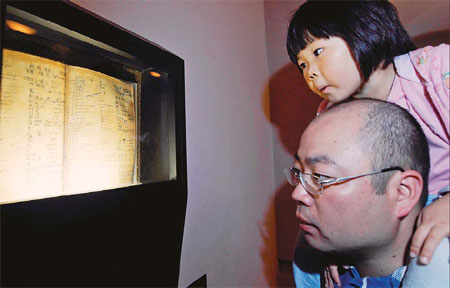|

A father and daughter look at an ancient Portuguese-Chinese dictionary inside the Portugal Pavilion. Photos Gao Erqiang / China Daily
|
|

A rotating multimedia globe with the first global map featuring China is showcased in the Portugal Pavilion. |
Historic text by 16th-century missionaries was first of its kind to introduce Chinese language and culture to the West, Wu Yiyao reports.
The ancient Portuguese-Chinese dictionary on display inside the Portugal Pavilion offers more than just words and definitions. It tells a story of Chinese history and social values.
The dictionary was compiled in 1583 by Italian missionaries Matteo Ricci and Michael Ruggieri. Both were well known for their achievements in introducing China to the rest of the world.
The dictionary includes Chinese values, Confucius' teachings and even a detailed categorization of the necessities of everyday life. It represents the first attempt by two European sinologists to bridge the gap between China and the West in terms of language and culture.
It also shows how Ricci aspired to find connections between China and the West at this point in his life. The text reflects a significant departure in tone from the earlier Renaissance period works that he produced after arriving in the country.
"The dictionary is so impressive. Students at that time must have worked very hard to study Chinese," said Yang Shiwen, a 13-year-old visitor to the pavilion.
Inside the pavilion, the dictionary and its yellowing pages sit beside a rotating multimedia globe. This also harks back to the first global map featuring China, which was created in 1623 by Emmanuel Diaz and Nicholas Longobardi and named one of the 10 maps that changed the world.
China and Portugal have a long shared history that dates back to the 16th century, when the European country colonized Macao. With Chinese now making up the largest Asian community in Portugal, the pavilion is keen to promote the potential of this bilateral relationship.
One of the ways it does this is with an energy-themed film showing how balancing energies plays a philosophical role in Portuguese economics and environmental policies vis--vis sustainable development.
Meanwhile, the pavilion's cork facade highlights a key strength of Portugal's economy as the world's leading exporter of cork, while the world-famous wines and freshly baked tarts inside hint at its culinary and gourmet specialties.
(China Daily 10/22/2010)

